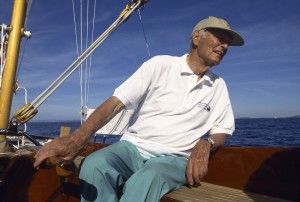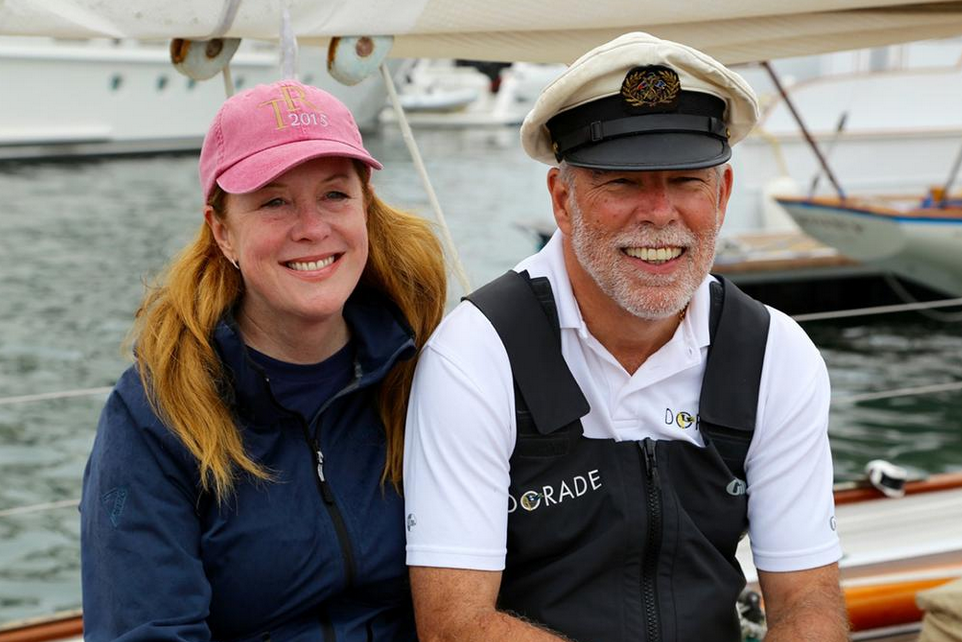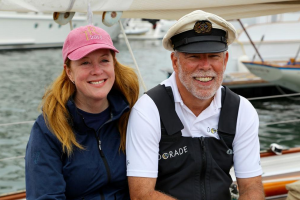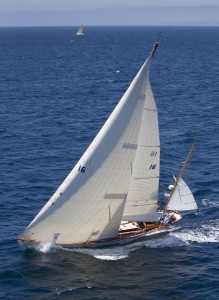November 20: Dorade, the 86 year old 52-foot Sparkman & Stephens classic yacht will debut at the Rolex Sydney Hobart, which starts on December 26, as her owners Matt Brooks and Pam Rorke Levy continue to campaign her hard in tough offshore races. The inboard yawl first became famous when she won the Transatlantic Race in 1931. Having also won that year’s Fastnet, her crew, led by the young Stephens brothers Olin and Rod, were treated to a ticker tape parade through the streets of New York – and an extraordinary design dynasty was born. Olin went on to become the pre-eminent yacht designer of his day designing America’s cup winners and a huge range of successful yachts from his and Rod’s S&S New York offices. But he always favoured Dorade as the ultimate deep water racing yacht design, and produced many bespoke sisters. And many, like Dorade herself, have been restored to race today.
Dorade made history again when she passed to Matt Brooks and Pam Rorke Levy, who restored her to offshore racing condition at Joe Loughborough’s Newport RI yard in 2010. They have since campaigned her successfully in many ocean races – most spectacularly winning the 2013 Transpac outright – an incredible, almost mind-boggling feat for a deep keel heavy displacement wooden yawl and a repeat of her first win of the gruelling offshore race some 77 years earlier.
She won the Transpac in 1936…
and again, in 2013
Recently the pair set their sights on some Down-Under prizes. And the 628nM Sydney Hobart comes after two Ozzy successes already – taking third place in the 370-mile Brisbane to Keppel Race and second place in IRC Passage Division 2 at Audi Hamilton Island Race Week, both of which concluded last month. “Dorade is an amazing yacht to be in the hunt against some very competitive modern boats at a very technical venue,” says Tactician Kevin Miller about their wins. “The boat and the team are performing well, even up against conditions that aren’t ideal for Dorade. She is an incredible yacht and always seems to surprise us.”
See photos below
Other Classics
To some, when it comes to boats, age is just a number. This same approach also includes Sean Langman, whose Maluka is another octogenarian yacht to take the Sydney Hobart course; although, in her case, this has become something of a tradition. Kialoa II will also raise a cheer; a line honours winner at the Rolex Sydney Hobart in 1971, she is on a journey to revisit the scenes of past glories in the hands of Patrick and Keith Broughton. While the prospects for repeating former triumphs are slim, all three crews will surely win hearts and minds of spectators and crew for their spirit and endeavour.
The rest of the race; Press Release from Rolex:
Rolex announced today that the 73rd Rolex Sydney Hobart promises much, with 107 yachts currently scheduled to cross the start line in Sydney Harbour at 13.00 (AEDT) on 26 December. Some 30 international entrants will participate, with a high-profile battle for line honours and fierce contest for the overall win expected. The 628-nautical mile race has never yet failed to deliver intense drama and great spectacle – the 2017 edition looks set to be no exception. First held in 1945, the Rolex Sydney Hobart is organized by the Cruising Yacht Club of Australia with the cooperation of the Royal Yacht Club of Tasmania. Rolex has been title sponsor since 2002. An unquestionably iconic sporting challenge, the race sits alongside the other offshore classics, such as the Rolex Fastnet Race and Rolex Middle Sea Race, that underpin the Swiss watchmaker’s association with the sport.
Last year, a four-way competition to finish first in Hobart resulted in a record-breaking performance by Perpetual LOYAL. Anthony Bell’s 100-foot Maxi rewarded her crew’s persistence and resolve, as man and machine combined to take nearly five hours off the previous fastest time.
Once again, four 100-foot powerhouses are in the running. Wild Oats XI will be seeking to re-establish her benchmark status by adding to her eight line honours successes and taking back the record, weather permitting. Against her, the American Maxi Comanche, first to finish in 2015, is competing under the stewardship of New Zealander Neville Crichton, a two-time line honours winner himself.
Peter Harburg’s Black Jack is the former Alfa Romeo – the fastest yacht in 2009 with Crichton. The Reichel/Pugh design has spent the past five years dominating the northern hemisphere big boat scene. Completing the quartet is Christian Beck’s InfoTrack (previously Perpetual LOYAL).
Racing these highly-tuned Maxis at full tilt over some of the most difficult seas in the world is a true test for both crew and yacht. Any weakness in organization, skill or determination will be ruthlessly exploited by the opposition and the conditions. Preparation is critical and one month out from the start, the race has already begun in earnest for the owners and crews of these pure thoroughbreds.
PEER PRIDE
Away from the rarefied atmosphere of the 100-footers, the majority of entrants are competing for a variety of reasons. Some are relatively simple: a passion for the sport, the camaraderie of teamwork or the opportunity to pit oneself against the challenge. There are prizes throughout the fleet, with classes separated into different bands under handicap. At the finish in Hobart, Tasmania though, one boat will stand head and shoulders above the rest. The crew that wins overall will receive the deserved recognition of their peers and take a place in event legend. Beyond these less tangible rewards, there are the coveted Tattersall’s Cup, with its many years of history, and the Rolex Oyster Perpetual timepiece, engraved with the race name, the year and the words “Overall Winner”.
Over the past fifteen years, the title and rewards have been shared across the fleet, with yachts in the 40 to 50-foot range winning five times and yachts between 50 and 60 feet also winning five times. There have been three wins from the 60 to 70 feet yachts and two wins from the 100 footers. The prevailing weather will be significant in determining the outcome of the race. Inevitably, the conditions favour different lengths of yacht at different times; the strength of the wind and the state of the sea play critical roles. Crews must manage their resources astutely and sail to their yacht’s full potential throughout the period at sea. Complacency and inattentiveness can be ruinous.
FORM BOOK
The 2016 overall winner is back, although in new hands and renamed Wizard. David and Peter Askew from the United States will have their work cut out to repeat the achievement of Jim Delegat and the crew of Giacomo. The last boat to secure back-to-back wins was Freya in 1965. Bob Steel, from New South Wales and owner of Quest, will be hoping the conditions suit the 50-footers. A winner in 2002 and 2008, his current boat also triumphed under the name Balance in 2015. Steel, too, is up against it. This segment of the fleet is full of pedigree. Italian yacht, Mascalzone Latino owned by Vincenzo Onorato, enters after back-to-back wins in her last two 600-mile outings: the 2017 Hong Kong to Vietnam Race and the 2016 Rolex Middle Sea Race.
Chris Opielok from Germany, owner of the TP52 Rockall, may be relatively unknown at this race but he is a proven offshore challenger winning the Admiral’s Cup twice. American Joseph Mele will continue his pursuit of bluewater racing’s greatest prizes. Fresh from participation at this year’s Rolex Fastnet and Rolex Middle Sea Race, Mele and his Triple Lindy team are entering their second successive Rolex Sydney Hobart. Ends.

Olin Stephens helms Dorade on her first sail after restoration at Cantiere Navale dell’Argentario June 1997, Porto Santo Stefano (Grosseto), Italy. Dorade is the yacht that started it all for Olin, who designed her when he was just 21. She was radical at the time and the fact she can still win races is a rules-defying testament to her exquisite classic lines.





